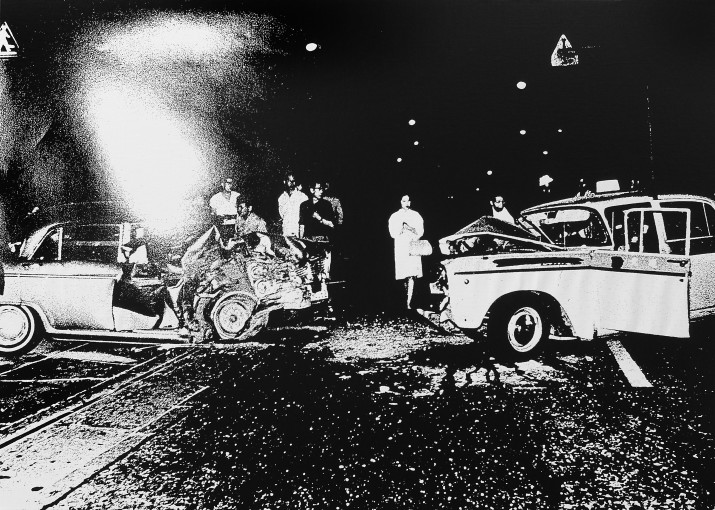Some of the silk-screen photographs at Daido Moriyama’s exhibition at Hamilton’s gallery depict wide shots of the bustling Tokyo street, the others close-ups of the body— a pair of parted lips, the intersection of crossed legs in fishnet stockings.These two types of imagery create, in combination, an uncanny inverting effect. This supplements the sense of inversion already produced by Moriyama’s grainy high-contrast black and white photographs. Without nuances of color and in uniformly sharp focus, the urban world these images capture becomes alarmingly inverted. Images of the body or of city crowds take on the heaviness and simplicity of inanimate objects, while street signs and cars dissolve with the ambiguity and complexity of living things. Difference gives way to sameness. The images resist narrative and the viewer feels warned against inserting characterizations.
Moriyama documents a Japan in flux decades after World War II and the post-war American occupation, one in which the traditional values of a long-isolated power collide with the country’s status as a fast-growing international hub with Tokyo at its heart. Moriyama’s distortions are indicative of a society in which national narrative has been disrupted— the literal physicality of the scene is all that remains. In photographs like “Untitled,” clichés of eroticism are reduced to form and repeated unto oblivion (without, in fact, even a title) because, Moriyama posits, without a clear cultural agreement as to the meaning behind the body, bodies become purely formal.
Untitled, 2001
Silkscreen on canvas
40 1/3 x 60 in
At his most spontaneous and daring, Moriyama points out the precariousness of even this most unambiguous thing, physical form. In “Smash-up,” the aftermath of a car accident is less frightening than the white shape that hangs over the scene. Post-nuclear warfare, the photographs’ distortions— heavy shadows, white blotches— become semi-literal representations of a physically impressive city growing in the shadows of its nation’s physical dissolution.

Smash-up, 1969
Silkscreen on canvas
43 1/3 x 61 3/8 in. (110 x 156 cm.)
The towering forms of body parts and billboards in these photographs stand in the face of potential destruction. Thus Moriyama first creates a world in which only physical form survives after a cultural fight to the death— and then he chips away at even this reality, glimpsing a reality in which physicality itself crumbles in the face of emptiness.
By Eleanor Stern
“Daido Moriyama: Scene” is at Hamilton’s Gallery until 17 August, 2018.

